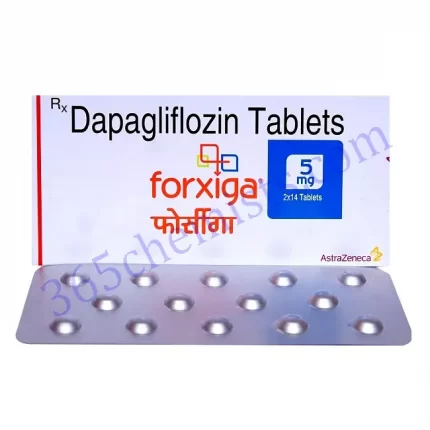Introduction
Dapagliflozin is the active ingredient of the drug Forxiga 10mg Tablet. To assist control blood sugar levels, it is administered to those with type 2 diabetes. The uses, dosage, side effects, warnings, and other details of Forxiga 10mg Tablet will all be covered in this detailed overview.
How Forxiga 10 Tablet Works
The pharmaceutical Forxiga 10 Tablet is a member of the group of drugs known as sodium-glucose co-transporter 2 (SGLT2) inhibitors. It functions by preventing the kidneys from reabsorbing glucose, causing more glucose to be expelled in the urine. People with type 2 diabetes can lower their blood sugar levels thanks to this method.
Uses of Forxiga 10 Tablet
The main purpose of Forxiga 10mg Tablet is to control type 2 diabetes. It is prescribed as a component of a full treatment programme that also includes a nutritious diet, consistent exercise, and additional diabetic drugs, if required. The Forxiga 10 Tablet aids in blood sugar regulation and may possibly provide further advantages including lowering the risk of cardiovascular issues.
Dosage and Administration
It is customary to take one Forxiga 10 Tablet by mouth each day, with or without food. The dosage that is advised may change based on a patient’s needs and the doctor’s guidance. It is crucial to adhere to the healthcare provider’s recommended dosage and administration guidelines.
Side Effects
Forxiga 10 Tablet side effects are possible, however not everyone will experience them. Typical negative consequences that could happen include:
- Genital Infections: The use of Forxiga 10 Tablet may raise the risk of genital infections, including male and female yeast infections and balanitis. Itching, redness, swelling, and discharge are possible symptoms. It’s critical to practise excellent hygiene and seek medical help if any symptoms develop.
- Urinary Tract Infections: Some people who take Forxiga 10 Tablet may develop urinary tract infections. Frequent urination, pain or burning when urinating, and murky or rancid-smelling urine are all possible symptoms. If these symptoms appear, immediate medical assistance is required.
- Hypoglycemia (Low Blood Sugar): Although it is uncommon, taking Forxiga 10 Tablet along with other diabetic drugs that lower blood sugar levels may raise the risk of hypoglycemia. Hypoglycemia can cause sweating, trembling, dizziness, weakness, and confusion. Regular blood sugar checks are crucial, as are actions taken to manage and prevent low blood sugar.
- Dehydration and dizziness: Forxiga 10 Tablet may increase the risk of these side effects, particularly in older people, people with kidney issues, and people using diuretic drugs. Maintaining hydration is crucial, as is steering clear of any actions that can cause excessive fluid loss.
- Other Adverse Reactions: Forxiga 10 Tablet may also cause less frequent adverse reactions, such as increased urination, increased thirst, changes in appetite, weight loss, and weariness. It’s crucial to speak with a medical expert if any strange or lingering adverse effects manifest.
Related Product
Forxiga 5 mg Tablet
Forxiga 10 mg Tablet
Precautions and Warnings
There are a few things to keep in mind when utilising Forxiga 10 Tablet:
- renal Function: People with impaired renal function or a history of kidney issues should use Forxiga 10 Tablet with caution. It’s crucial to regularly check on kidney function while receiving treatment.
- Forxiga 10 Tablet may temporarily lower blood pressure, which is known as hypotension (Low Blood Pressure). Although this side effect is typically minor, those who have experienced low blood pressure in the past or who are currently on blood pressure-lowering drugs should use Forxiga 10 Tablet with caution.
- Forxiga 10 Tablet should not be used by those with type 1 diabetes or those who have experienced diabetic ketoacidosis in the past. Before beginning therapy, it’s critical to let the doctor know what kind of diabetes you have.
- Surgery and medical operations: Before having surgery or receiving medical procedures, it’s crucial to let the doctors know that you’re taking Forxiga 10 Tablet because it could need to be temporarily stopped.
Interactions and Contraindications
It is crucial to let the healthcare practitioner know about all current medications being taken because Forxiga 10 Tablet may interact with other prescription drugs, herbal supplements, or dietary supplements. When combined with Forxiga 10 Tablet, some drugs, such as diuretics, may raise the risk of dehydration. Furthermore, those who have a history of hypersensitivity to dapagliflozin or any other prescription component should not take Forxiga 10 Tablet.
Storage and Handling
The Forxiga 10 Tablet needs to be kept at room temperature, free from heat and moisture. It’s crucial to keep the medication out of kids’ and animals’ reach. Medication that has expired or has not been used should be properly disposed of in accordance with local regulations.
Pregnancy and Breastfeeding
It’s not advisable to take Forxiga 10 Tablet if you’re pregnant or nursing. Before using this drug in certain circumstances, it is crucial to go over the potential risks and advantages with a medical practitioner.
If Forxiga 10 Tablet crosses into breast milk is unknown. Before using this drug, nursing moms should speak with their doctor.
Heading: Monitoring and Follow-up
During Forxiga 10 Tablet therapy, regular monitoring of blood sugar levels, renal function, and other pertinent data is crucial. It is advised to schedule follow-up visits with a medical professional to assess the medication’s efficacy and resolve any worries or inquiries.
Conclusion
For people with type 2 diabetes, Forxiga 10 Tablet works well for controlling blood sugar levels. It lowers blood glucose levels by preventing the kidneys from reabsorbing glucose. While Forxiga 10 Tablet may be advantageous, it’s critical to be informed of any risks and safety measures. Always abide by the recommended dosage and seek out individualised advice and direction from a healthcare professional before using Forxiga 10 Tablet.










